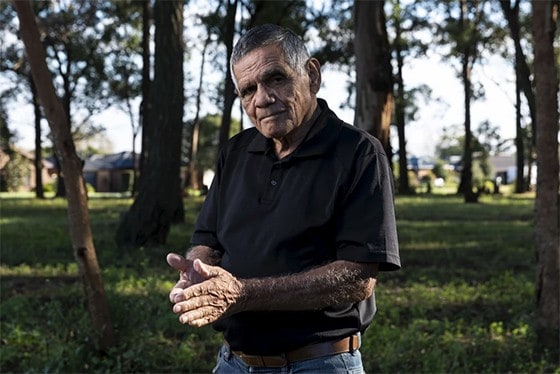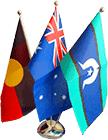
Dana McCauley, Sydney Morning Herald, 21 June 2020
Cancer has overtaken circulatory disease as the leading cause of Indigenous deaths in NSW and Victoria, prompting a new campaign aimed at improving screening, treatment and lifestyle factors.
John Delaney, a Kamilaroi elder who was diagnosed with lung cancer six years ago, smoked cigarettes for 37 years before quitting at the age of 50, and he now tries to impart upon the younger generation the importance of avoiding tobacco.
“Nothing peeves me more than seeing young kids like I was myself with a cigarette hanging out of their mouths,” he said.
“I started at 13. It was a man thing to do back in those days … It was great stuff, to be considered a man. I was smoking 90 cigarettes a day.”
The latest data from the NSW Cancer Institute shows the number of Indigenous cancer deaths rose by 68 per cent over 12 years, hitting an average of 218 per year in 2014-18, up from 129 in 2006-2010. By comparison, Indigenous deaths caused by circulatory diseases such as stroke and heart attacks rose from an average of 175 to 188 a year in the same time frame.
The latest Australian Bureau of Statistics data from Victoria shows a similar trend, with cancer also overtaking circulatory disease in 2014-18. The ABS does not report raw figures for Victoria due to poor identification of the Aboriginality of people who have died in the state, meaning the number of Indigenous deaths is likely to be understated.
Mr Delaney, 86, is undergoing radiation therapy to reduce the size of his tumours.
One thing that struck him when he went for treatment was his doctor’s comment about how infrequently he treated Aboriginal cancer patients.
“He said, ‘Don’t Aboriginal people get lung cancer?’ I said, ‘It’s not diagnosed early enough.’ People die without finding out they’ve got it.”
Mr Delaney credits the introduction of the Aboriginal Medical Service in the 1970s with increasing his life expectancy, by working out he was at risk of a stroke.
He said that after suffering headaches while working as a public servant in his 40s, “I went to 10 different mainstream GPs and they all said to take some Bex powder and lie down”.
It was only when he went to the Aboriginal Medical Service that a GP examined his full family history and put him on blood-thinning medication, helping him avoid the fate of his father and uncles who “all had strokes”.
A cancer diagnosis in his latter years was something he could accept. “I said if I was 39 or 40, I’d be real pissed off. At 81, it’s not that devastating.”
Encouraging his daughter to have breast cancer screening in her 50s secured a diagnosis that was early enough for treatment to be successful.
“There needs to be a big awareness blast,” he said.
Aboriginal Health and Medical Research Council chief executive Robert Skeen – whose organisation works in partnership with the Cancer Institute NSW – said outreach to help Indigenous Australians lower their cancer risk was crucial to tackling the increase.
“Tobacco use is still high in the community, from a young age as well,” he said.
Cancer Institute NSW chief executive and Flinders University professor David Currow said healthcare initiatives had dramatically reduced circulatory disease in the Indigenous community, but high rates of cancer deaths were “concerning”.
The reasons were complex, he said, with diet, obesity, smoking and alcohol use playing a role, along with viral infections such as Hepatitis B and C.
“It’s really clear there are some lifestyle factors that are modifiable,” Professor Currow said.
“The Cancer Institute is working with the Aboriginal Health and Medical Research Council to ensure Aboriginal elders are at the decision-making table in co-designing solutions.”
Lung, breast, liver, colorectal, prostate, throat and tongue cancers are the most common cancers among Indigenous people, along with cervical cancer, which has both a higher incidence and death rate.
According to the Cancer Council Victoria, incidence and mortality rates among Aboriginal Victorians are more than double those of non-Aboriginal Victorians for many cancers.
Professor Currow said while there was a perception in the community that Aboriginal cancer patients presented later than non-Aboriginal patients, “outcomes in cancer care are still worse [for Indigenous patients] … even after adjusting for the timing of presentations”.
Screening programs and physical exercise were part of improving outcomes, he said.
The Victorian government has identified cancer as a priority focus area under its Aboriginal health, wellbeing and safety strategic plan 2017–27, which notes that cancer mortality rates are significantly higher for Aboriginal Victorians compared to non-Aboriginal Victorians.
The plan states that better cancer outcomes for Aboriginal people can be achieved by making cancer care more “culturally responsive”.
Originally published: https://www.smh.com.au/politics/federal/cancer-the-leading-cause-of-indigenous-deaths-after-large-spike-20200619-p5549h.html
